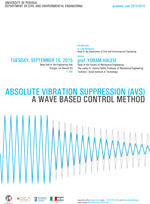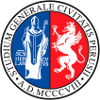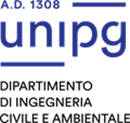 On Tuesday September 15th at 11:00 am, Prof. Dr. Yoram Halevi, Dean of the Faculty of Mechanical Engineering of the Technion - Israel Institute of Technology will deliver a conference entitled "Absolute Vibration Suppression (AVS) - a wave based control method" at the main Hall of the Campus of Engineering of University of Perugia. Below the abstract of the conference and short bio of the speaker. The flyer of the conference is available [here].
On Tuesday September 15th at 11:00 am, Prof. Dr. Yoram Halevi, Dean of the Faculty of Mechanical Engineering of the Technion - Israel Institute of Technology will deliver a conference entitled "Absolute Vibration Suppression (AVS) - a wave based control method" at the main Hall of the Campus of Engineering of University of Perugia. Below the abstract of the conference and short bio of the speaker. The flyer of the conference is available [here].
Short bio:
Yoram Halevi received his B.Sc., M.Sc. and D.Sc. degrees from the Faculty of Mechanical Engineering at the Technion, Israel Institute of Technology in 1974, 1981 and 1985 respectively. He is currently the Dean of the Faculty and the James H. (Jimmy) Belfer Professor of Mechanical Engineering. He held visiting positions at Penn State, Ohio State and Virginia Tech in the US and in CNR-ITIA in Milan, Italy as well as short term visits to other universities and research institutes. Yoram Halevi is a fellow of ASME. His current research interests are in control of flexible structures, optimal control of redundant actuation systems, model order reduction and model updating.
Abstract:
Modeling and control of continuous flexible structures is one of the most challenging problems in control theory. This topic gains more interest with the development of slender space structures, light weight aeronautical components etc. It should also be noted that 'flexible' is a relative term so with increased accuracy requirements the structure cannot be regarded as rigid body. The first and most common approach is to approximate the infinite dimension system by a finite approximation, usually Finite Element Method (FEM) and then use standard techniques, e.g. H2 or H∞, to design the controller. While transforming the problem into the familiar and well explored realm of finite dimension linear systems is convenient, the approach has two inherent drawbacks. First, insight into the system is lost and secondly, reasonable accuracy requires very high order models which increase the controller dimension as well.
A different approach, which will be discussed in this talk, is modeling by means of traveling waves and designing a controller from that point of view. The Absolute Vibration Suppression (AVS) control method was first introduced for second order flexible structures that are governed by the wave equation. The first step was accurately modeling those systems by infinite dimension transfer functions with a distinct structure, consisting of low order rational elements and pure time delays. The delay arises from the time it takes the wave to travel from the actuation to the measurement point, directly and after reflections, and is completely missing from the modal and FEM models. The AVS method can be interpreted as absorbing the wave at the edge. The controller eliminates the vibrations completely and hence its name.
When considering other types of flexible systems such as beams and membranes, the rational transfer functions and the 'delays' become fractional order with much added complexity in the modelling, controller design and implementation phases. The talk will give an overview of the general modelling and control framework, its relationship with other approaches and points that are still open for future research.


